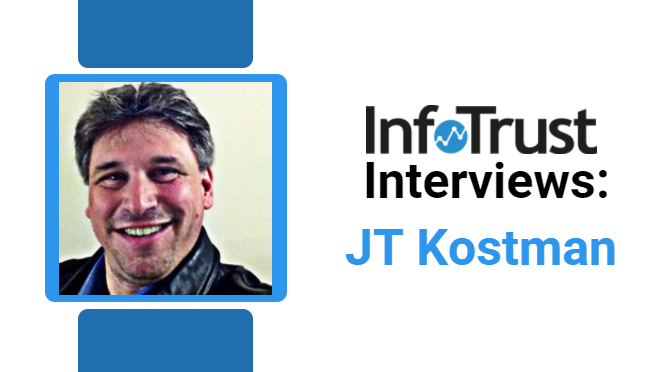
JT Kostman is a Data Scientist, Mathematician, Psychologist and Chief Data Officer for Time Inc. Over the past 20 years he has provided data-driven insights into human behavior for organizations ranging from the Fortune 500 to the U.S. Federal Government.
AG: First off, could you tell me your job title and responsibilities at Time Inc.?
JT: I am Chief Data Officer for Time Inc.. That means I am in charge of extracting value from our data assets and working in concert with all of our partners; whether they are our advertisers, our business partners, or our vendors – and we use those capabilities to serve four major internal clients.
A big focus of our activities is in supporting ad sales – to make sure we’re targeting effectively so we get the right ads to the right people at the right time in order to better segment our customers and understand who our customers’ customers are and who they’re trying to reach, where they are across all regions and what messages resonate with them and work with them most effectively.
Our second customer is our consumer group, and those are the people who are interested in having conversations to acquire more subscribers, reaching more people who are interested in buying our magazines at the newsstand, attend our events, subscribe to our digital properties, or watch our videos.
Our third customer is editorial and we work to help inform our writers and editors of what the market is interested in, what are the trending hot topics, what are the things that people would like to hear more about and how well does our content resonate with our audiences. Are they satisfied? Are they happy? Do they like the content we’re producing?
And the fourth group would be my own group as we are starting to treat data as an asset and beginning to leverage data opportunities.
AG: What do you love the most about your job?
JT: That’s easy. My whole career, what I love the most, is working with really, really smart people to solve what other people think are impossible problems. We have been given the remit from the time I started to fundamentally change the world of digital advertising, of advertising in general and of publishing. So no small challenges.
We have constant challenges; puzzles, in fact. When people join my team, I give them a present. Every member gets a pair of what we call “interrogative dice”. These are dice on which the faces read “who”, “what”, “when”, “where,” “why”, and “how”. I tell our new team members to roll the dice – and that’s their job. Their job is to roll the dice with their internal and external clients and answer those questions for them. So that’s what we do. We get paid to answer really cool questions. And I get to work with some of the best I have ever worked with. We have data scientists, engineers, analysts, marketing professionals, digital professionals and just these great, positive folks who report to me and work to answer those questions.
AG: For people outside of the industry, when you say something like data analyst or data scientist, how would you describe those positions to them?
JT: Boy, that’s actually a tricky question. I think data science is still kind of a wild west, something left up to interpretation. People say it’s part hacking skills, part math and part business acumen. Frankly, I think that’s kind of nuts. What I think of when I’m looking for data scientists and when I think who is a data scientist, I think of someone who is extremely intelligent, highly numerate, insatiably curious, technologically savvy, and has a great ability to to explain problems mathematically or through models using scientific, quantitative and qualitative methodology .
[bctt tweet=”I think data science is still kind of a wild west, something left up to interpretation.” username=”@infotrustllc”]AG: I hear you talking a lot about data and science. One of the things that we have been hearing a lot from the general media and companies is that analytics and data is becoming increasingly important. We heard the term ‘big data’ two or three years ago. It was a real hot buzzword. Why do you think big data and the use of analytics has become such an important topic among the business community over the last couple of years?
JT: I think it’s the same reason why you couldn’t really be an astronomer until Lippershey invented the telescope or a biologist until Janssen invented the microscope. We now have the instrumentality and the mechanisms to be able to understand our world at a deeper and more profound level than ever before – and now, trying to do business without those tools puts you at a distinct disadvantage.
AG: What does your analysis process look like daily, weekly, monthly? Is there a certain process that you guys use to identify things that you want to analyze and look into more? Is there some kind of structure or framework that your team uses on a regular basis?
JT: People often ask me what the distinction is between a Chief Data Officer and a Chief Technology Officer and, I think the main difference is that a CTO and his or her organization is an investment that every organization should make, and must make. It’s a sunk cost that is part of doing business and it’s not expected to net a direct result.
Everything a CDO does, in my humble opinion, should be monetizable. Everything we do should accelerate the agenda of the organization. If you’re in a commercial organization, that should be dollars, if you’re in a governmental organization, that should be whatever the mission is, profits etc.
My decisions, my strategy, are predicated on my belief that we should monetize everything. Everything we’re working on, every single project. All our priorities are decided by the their monetary value to the organization. Ultimately, what we decide to focus on is based on how much valuable our actions bring to our audience members, our advertisers, and our editors.
AG: I’m assuming you guys do a lot of reporting or presentations to make sure that everyone in your organization understands what you’re doing and what the results are. How do you keep those presentations interesting, entertaining, and actionable? We hear a lot of the times that data and numbers people aren’t necessarily the best presenters. Do you have any tips for the people that are in the weeds but also need to be able to present that data on a high level?
JT: Fortunately for us, we get to cheat. Remember that Time Inc. is one of the greatest storytelling organizations in the history of the world. We’ve been doing for almost a hundred years – and we’re pretty good at it. We tell compelling stories. And so we tap into some of that talent. We partner with our internal colleagues and learn from them.
AG: What types of tools do you guys currently use? What are the skills that are important for people that want to get into data science and data analytics?
JT: I’m probably a bit unusual as a CDO in that I’m very tool agnostic. I don’t believe in saying we’re an R shop, or we’re a Python shop. I have people in my group that use SAS, SPSS, R, and Python. I have people who are and aren’t Big Data friendly. I have people that can code in their sleep and other people who would be lost without a clickable UI. I take a very ensemble approach to building our team and to the tools we use.
For me, there is no one magic tool or solution, but if you want to be a carpenter, or a plumber, or an electrician, you should know how to use all the essential tools in the box. With that said, I don’t think you have to be able to create every algorithm from the ground up. If you can get the machines to do what you want them to do, or can partner with other people that can, that’s all that’s important.
With all that said, I think the single most important tool in the Data Scientist’s toolkit is the grey squishy wetware we keep between our ears. If you can think, and you think effectively; If you can think algorithmically, computationally, and mathematically; If you can abstract the problem, and understand it empirically; you have all the tools you need to succeed.
[bctt tweet=”the single most important tool in the Data Scientist’s toolkit is the grey squishy wetware we keep between our ears” via=”no”]AG: Industry reports have been projecting a shortage of analytics talent over the coming years. How can companies like TIME address these problems and get more analysts and data scientists not only into the field but in the pipeline for future job openings?
JT: We haven’t really had a problem with attracting talent. I think most organizations have asked that question wrong headedly. We’re worrying about how we create more data scientists. I’m more concerned with how I get the best ones to work for me. And if the rest of the market needs to attract them, then I think it just ups the game for all of us.
AG: For people that are interested in analytics and data science and want to keep up with the latest news are there any types of blogs, books, or other resources that you read on a daily basis just to keep up with?
JT: There are so many you have me at a loss. I read voraciously. I usually read three or four books a week. And I read every blog, every article I can get my hands on. I really think you can’t get enough. Some of the blogs, LinkedIn posts, are fantastic.
And then I also think you have to go beyond the “pure data science”. I pick up stuff from IT, mathematics, and even other areas. I read Wired Magazine, MIT Technology Review, Popular Science, and Scientific American religiously. I think you have to be open to this kind of renaissance thinking.
AG: How much time do you spend every day reading and learning new things?
JT: Well that is my job. You just described my entire day. But specifically to advancing my capabilities and thinking; now you’ve tapped into my dark secret that I’m not supposed to tell anyone. I have a five hour round trip commute to work everyday. So the entire train ride, to and from, I read, I watch videos, I learn new things. So I’ve sort of dedicated five hours a day to taking in new information.
If you want to succeed in this economy, this market, and particularly in this profession, you have to be a lifelong learner. You have to have an insatiable appetite for knowledge. You have to be passionate. You have to really love this stuff. And so I spend a lot of my free time doing just that.
You know, I’m one of the luckiest professionals on the planet. I know how pro ballplayers feel. I’m always telling my colleagues, friends, family, anyone who will listen, “I can’t believe they actually pay me to do this!”






